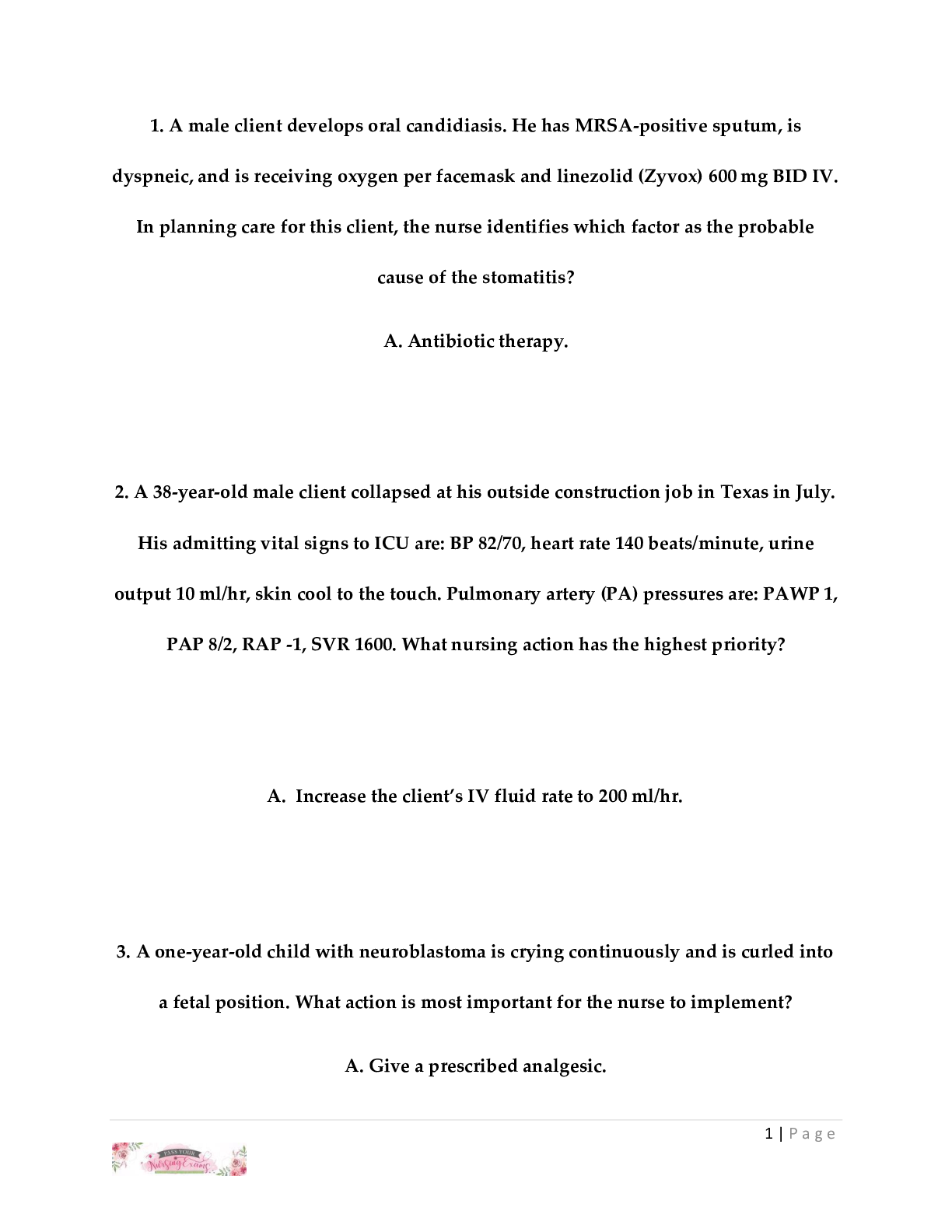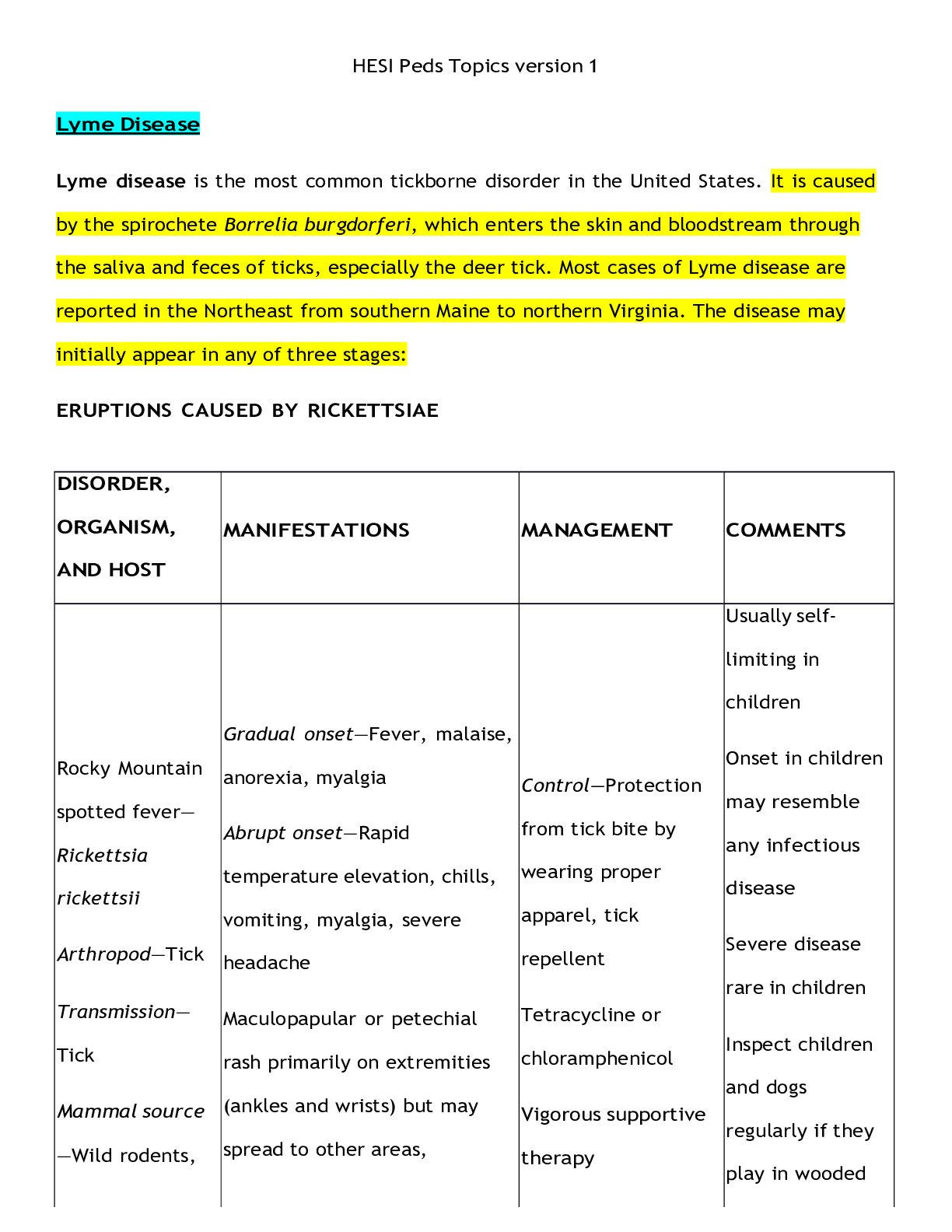Health Care > HESI > Pharmacology Exit HESI (A Graded) Latest Questions and Complete Solutions (All)
Pharmacology Exit HESI (A Graded) Latest Questions and Complete Solutions
Document Content and Description Below
Pharmacology Exit HESI (A Graded) Latest Questions and Complete Solutions After abdominal surgery prescribed low molecular weight heparin (LMWH) This medication is a blood thinner given to prevent... blood clot formation An antacid, (Maalox) is prescribed for a client with peptic ulcer Dz Maintain a gastric pH of 3.5 or above Pt states “I am allergic to penicillin” Cephalosporins A category X drug is prescribed for a young adult female client Use a reliable form of birth control - A category X drug is prescribed for a young adult female client. Which instruction is most important for the nurse to teach this client? A) Use a reliable form of birth control. B) Avoid exposure to ultra violet light. C) Refuse this medication if planning pregnancy. D) Abstain from intercourse while on this drug. - Drugs classified in the category X place a client who is in the first trimester of pregnancy at risk for teratogenesis, so women in the childbearing years should be counseled to use a reliable form of birth control (A) during drug therapy. (B) is not a specific precaution with Category X drugs. The client should be encouraged to discuss plans for pregnancy with the healthcare provider, so a safer alternative prescription (C) can be provided if pregnancy occurs. Although the risk of birth defects during pregnancy explains the restriction of these drugs during pregnancy, (D) is not indicated. Admitted to the hospital for Dx testing for possible myasthenia gravis prepares for IV administration of edrophonium chloride (Tensilon) Decreases muscle weakness - A client is admitted to the hospital for diagnostic testing for possible myasthenia gravis. The nurse prepares for intravenous administration of edrophonium chloride (Tensilon). What is the expected outcome for this client following administration of this pharmacologic agent? A) Progressive difficulty with swallowing. B) Decreased respiratory effort. C) Improvement in generalized fatigue. D) Decreased muscle weakness. - Administration of edrophonium chloride (Tensilon), a cholinergic agent, will temporarily reduce muscle weakness (D), the most common complaint of newly-diagnosed clients with myasthenia gravis. This medication is used to diagnose myasthenia gravis due to its short duration of action. This drug would temporarily reverse (A and B), not increase these symptoms. (C) is not a typical complaint of clients with myasthenia gravis, but weakness of specific muscles, especially after prolonged use, is a common symptom. Which symptoms are serious adverse effects of Beta-adrenergic blockers such as propranolol (Inderal) Wheezing, hypotension and AV block - (B) represents the most serious adverse effects of beta-blocking agents. AV block is generally associated with bradycardia and results in potentially life- threatening decreases in cardiac output. Additionally, wheezing secondary to bronchospasm and hypotension represent life-threatening respiratory and cardiac disorders. (A, C, and D) are not associated with beta-blockers. Prescribed atorvastatin (Lipitor) one month ago calls the triage nurse at the clinic complaining of muscle pain and weakness in his legs Make an appointment to see the healthcare provider because muscle pain may be a serious side effect - A client who was prescribed atorvastatin (Lipitor) one month ago calls the triage nurse at the clinic complaining of muscle pain and weakness in his legs. Which statement reflects the correct drug-specific teaching the nurse should provide to this client? A) Increase consumption of potassium-rich foods since low potassium levels can cause muscle spasms. B) Have serum electrolytes checked at the next scheduled appointment to assess hyponatremia, a cause of cramping. C) Make an appointment to see the healthcare provider, because muscle pain may be an indication of a serious side effect. D) Be sure to consume a low-cholesterol diet while taking the drug to enhance the effectiveness of the drug. - Myopathy, suggested by the leg pain and weakness, is a serious, and potentially life-threatening, complication of Lipitor, and should be evaluated immediately by the healthcare provider (C). Although electrolyte imbalances such as (A or B) can cause muscle spasms in some cases, this is not the likely cause of leg pain in the client receiving Lipitor, and evaluation by the healthcare provider should not be delayed for any reason. A low-cholesterol diet is recommended for those taking Lipitor since the drug is used to lower total cholesterol (D), but diet is not related to the leg pain symptom. The healthcare provider prescribes naproxen (Naproxen) twice daily for a client with osteoarthritis of the hands Another type of non- steroidal anti-inflammatory drug may be indicated - The healthcare provider prescribes naproxen (Naproxen) twice daily for a client with osteoarthritis of the hands. The client tells the nurse that the drug does not seem to be effective after three weeks. Which is the best response for the nurse to provide? A) The frequency of the dosing is necessary to increase the effectiveness. B) Therapeutic blood levels of this drug are reached in 4 to 6 weeks. C) Another type of nonsteroidal antiinflammatory drug may be indicated. D) Systemic corticosteroids are the next drugs of choice for pain relief. - Individual responses to nonsteroidal antiinflammatory drugs are variable, so (C) is the best response. Naproxen is usually prescribed every 8 hours, so (A) is not indicated. The peak for naproxen is one to two hours, not (B). Corticosteroids are not indicated for osteoarthritis (D). Dose of isosorbide dinitrate (Imdur) is increased from 40 mg to 60 mg PO daily administer the 60 mg dose of Imdur and a PRN dose of acetaminophen (Tylenol) - A client's dose of isosorbide dinitrate (Imdur) is increased from 40 mg to 60 mg PO daily. When the client reports the onset of a headache prior to the next scheduled dose, which action should the nurse implement? A) Hold the next scheduled dose of Imdur 60 mg and administer a PRN dose of acetaminophen (Tylenol). B) Administer the 40 mg of Imdur and then contact the healthcare provider. C) Administer the 60 mg dose of Imdur and a PRN dose of acetaminophen (Tylenol). D) Do not administer the next dose of Imdur or any acetaminophen until notifying the healthcare provider. - Imdur is a nitrate which causes vasodilation. This vasodilation can result in headaches, which can generally be controlled with acetaminophen (C) until the client develops a tolerance to this adverse effect. (A and B) may result in the onset of angina if a therapeutic level of Imdur is not maintained. Lying down (D) is less likely to reduce the headache than is a mild analgesic. [Show More]
Last updated: 1 year ago
Preview 1 out of 43 pages
 Latest Questions and Complete Solutions.png)
Reviews( 0 )
Document information
Connected school, study & course
About the document
Uploaded On
Jun 06, 2021
Number of pages
43
Written in
Additional information
This document has been written for:
Uploaded
Jun 06, 2021
Downloads
0
Views
36

 100 QUESTIONS AND ANSWER(S) WITH RATIONALE TEST PREP GUIDE GRADED A+.png)
.png)








 Latest Questions and Complete Solutions.png)
 Latest Questions and Complete Solutions.png)
 Latest Questions and Complete Solutions.png)
 Latest Questions and Complete Solutions.png)
 Latest Questions and Complete Solutions.png)

, Latest Questions and Answers with Explanations, All Correct Study Guide, Download to Score A.png)
, Latest Questions and Answers.png)


 LATEST QUESTIONS AND COMPLETE SOLUTIONS.png)





, Latest Questions and Answers with Explanations, All Correct Study Guide, Download to Score A.png)
, Latest Questions and Answers with Explana.png)


